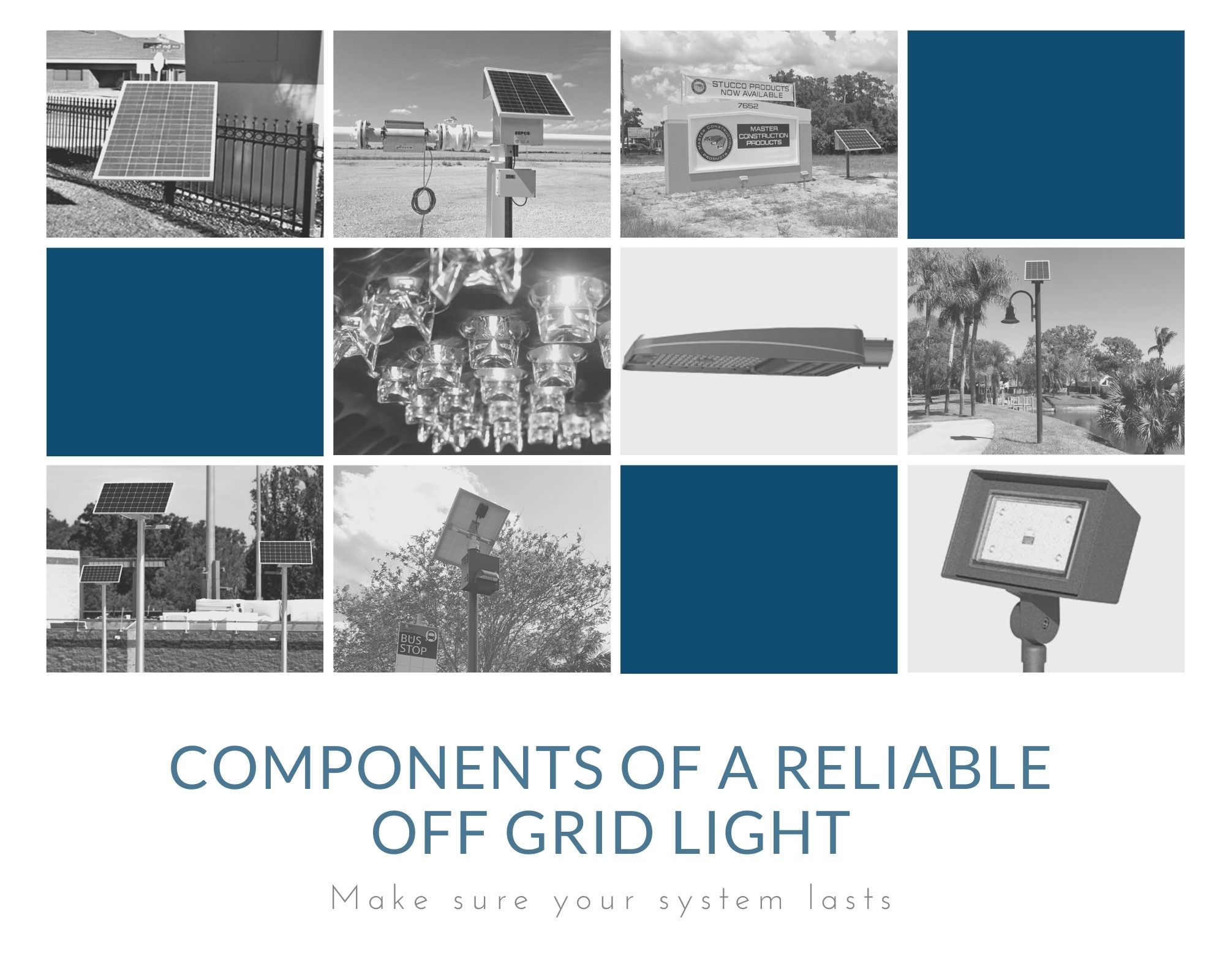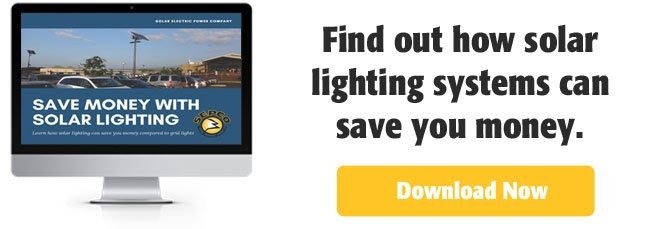
Contents
There are many different variables with an off-grid lighting system in today's market. Understanding what each component consists of, how it relates to the whole system in general, and what are the differences between system setups, will guarantee you make an informed decision when purchasing your next off-grid solar lighting system.
Solar Panel
The solar panel provides the power to the light fixture by capturing the sun and moving that energy into a storage system. This is done by light photons striking a solar cell and knocking electrons free from the silicon atoms of the crystal structure of the cell.
Or to put it more simply, the solar panel collect the energy produced by the sun during the day. The brighter the sun, the more energy it can produce; however, solar panels can still produce energy even on cloudy days.
Solar sizing takes into consideration the amount of sunlight that is available at the installation location on the worst-case time, typically December. It then calculates how much solar is required to operate the equipment for the required time frame, be it dusk to dawn, 24/7, a few hours, etc. This typically ranges from 5 hours in sunny areas and down to 1 hours in some of the most northern climates.
Battery Backup
Battery backups are comprised of a setup of one-to-many batteries all wired in series or parallel, depending on the installation and system setup requirements. The battery system can be comprised of AGM glass mat, GEL cell, Lithium, and most recently Saltwater setups.
The battery system takes the energy produced during the day and stores it for use later, typically at dusk for a set period. System sizing takes into consideration the amount of time required to operate the light fixture (or other equipment) and sizes the backup system accordingly.
There are many schools of thought when it comes to a battery backup. For example, here at SEPCO, we provide a minimum of five nights backup as we use GEL cell technology. There are many reasons for this, but one of the main factors is it provides the customer with a reliable system that will work even when the weather is bad.
Lithium batteries are becoming more popular; however, there are many flaws still existing such as lack of performance in extreme temperatures (over 100°F or under 30°F). Many manufacturers using this technology also undersize the battery capacity, providing only a single night backup. Therefore, if there is bad weather or the solar does not allow for a full charge the next day, the system can easily fail, leaving the customer in the dark.
Light Fixture
The light fixture can be implemented in one of two ways; either by powering it directly with a DC driver or using an inverter. There are benefits to both types of setups and depends on other factors. DC-powered systems are the most efficient way, and how we power our systems.
A DC driver is the most efficient way to power the light from the battery. LEDs operate off DC power intrinsically and do not require the need to change the power source. As this is the most efficient way to power the LEDs, there is no need to oversize the system to handle the power losses that come with an inverter system.
Powering AC fixtures creates a lot of power losses but is done for some applications; though rare. Not only are there power losses due to the LEDs not operating on current that is natural to them, but also causes excess heat to be produced, one of the biggest factors to power losses.
Using DC powered LED fixtures is the most efficient and cost-effective way to provide the required light. Having the LED operate cooler can extend their life and can provide better efficiencies such as LpW and light output.
LED fixtures are also constructed with various lumen outputs, distributions, finishes, etc. Make sure the fixture fits the aesthetic of the project, had the finish necessary to fit into the project, and verify all other finishes of the complete unit. Industrial units provided by SEPCO use fixtures like the Viper while more decorative systems use the Urban. Both fixtures have the same light output, distributions, etc. but look completely different from one another.
Controls
There are many different control electronics on the open market today. Each one has its various features and benefits. Ensuring proper testing has been done to the control electronics and its operation with the system is crucial to making sure the system operates as intended and provides the needed features of your lighting system.
Controls provide the charging mechanics behind making sure enough power is produced from the solar panels to the batteries to allow for a full charge, does not overcharge the system, and keeps everything balanced. Having the wrong controls can destroy the battery backup by not keeping the batteries at their prime.
Controls also offer various operation profiles depending on the installation needs. Some installations require all night operation with no reduced or off times. These critical installations are the most energy heavy systems and need controls that are not field adjustable or have smart controls that can change the operation based on another factor.
Other controls include the use of adaptive lighting or dimming schemes, on and off times such as dusk activated for x number of hours and then turning off, split time operation where the lights or equipment comes on a few hours after dusk and then before dawn again, always on for some applications, and even systems that use motion sensors or switches.
Brackets and Pole
The brackets and poles are designed to meet the needs of the system. Solar panels are mounted on a pole using a racking system of some sort. Our bracket features a substantial aluminum channel for mounting to any pole or wall and providing a low profile to provide maximum strength for wind loading for the location of installation. We also mount using a post top design for some applications as well. Other solar mounts are available and vary from one manufacturer to another.
The fixture bracket is used to mount the fixture below the solar panel. This is typically an industry-standard bracket that through-bolts to the pole to allow for the fixture to mount at the recommended mounting height. This varies from short brackets keeping the fixture close to the pole, long arms to allow the fixture to shine out a distance from the pole location, and even decorative brackets for keeping with the aesthetic of the design.
The final component is the pole. This needs to be designed to meet local AASHTO wind load requirements with the solar power assembly mounted to it. Standard light poles are not manufactured to handle higher weights in certain wind zones, such as hurricane prominent areas.
These light poles can be manufactured out of many different materials and designs, however, the most popular is either aluminum or steel galvanized and either anchor base or direct burial. The poles provided by SEPCO are always designed with the system in mind and engineered to meet the local wind load requirements.
Every system should be thought of as a complete unit. Is it sized properly? Do all the components operate together without issues? Where are there holes in the specification? Look through everything and make sure it will work for your project. If you have questions, ask the supplier. A reliable off-grid lighting system should be able to provide reliable lighting for many years with little to no maintenance and a good return on investment.

